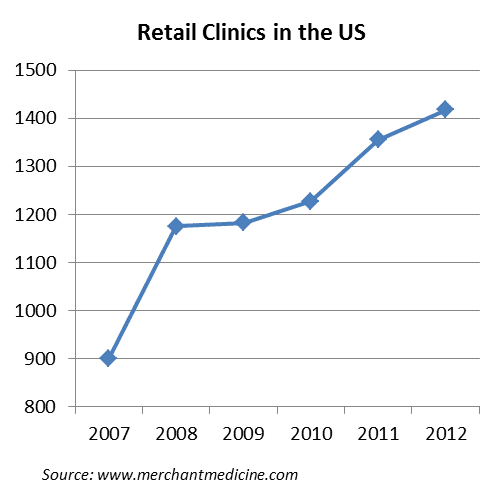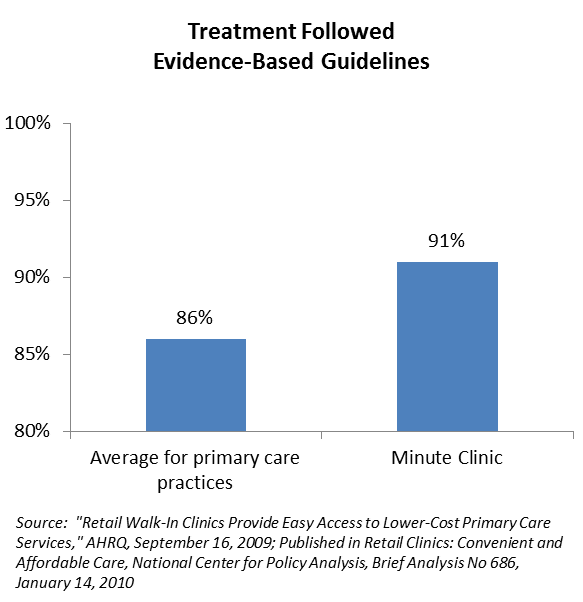Jeff Wheeler, an intern at the Clayton Christensen Institute, and I coauthored this piece.
If you’ve visited a Walgreens recently you may have noticed something new and different. Over 370 of their stores are now home to a “Take Care Clinic” (soon to be rebranded as “Healthcare Clinic”)—Walgreens’ retail clinic where nurse practitioners diagnose and treat simple conditions, all with no appointment and usually no wait. As you walked through the aisles, you may have noticed a Walgreens employee assisting customers that were looking for cold remedies, directing those with treatable symptoms to the Clinic.
The Healthcare Clinic is conveniently located, clearly identified, open after normal working hours and on the weekends, inexpensive, and the patient experience is carefully optimized. Basically, it is everything that the average American really wants in a healthcare ser
Basis of competition
There are over 1,400 retail clinics in the United States (see chart at right), an increase of over 50% since 2007. What is driving this incredible growth in retail clinics? The basis of competition in primary care is shifting as general practitioners are over-serving the average customer. In virtually all industries, including primary care delivery, customers initially demand performance and reliability from a product or service, for which they are typically willing to pay a premium price. Once a product is “good enough” and meets a customers’ performance requirements, however, customers will begin to select based on speed, convenience and price rather than solely performance or reliability. When this happens, providers that continue to offer high priced, highly customized service will almost always lose their business to their speedy, flexible, cheap competitors.
Disrupting general practitioners
When the diagnosis and treatment of simple conditions was in the realm of intuitive medicine, it was important to have highly trained MD’s care for  patients. As causal mechanisms and precise treatment for strep throat and similar ailments have been discovered, nurses can reliably and predictably treat these “boring” conditions. The retail clinic business model allows nurse practitioners to provide high quality care faster, in more places, and at a lower cost than any general practitioner could.
patients. As causal mechanisms and precise treatment for strep throat and similar ailments have been discovered, nurses can reliably and predictably treat these “boring” conditions. The retail clinic business model allows nurse practitioners to provide high quality care faster, in more places, and at a lower cost than any general practitioner could.
General practitioners sometimes argue that retail clinics do not perform well enough or are not reliable enough, because that is the basis of competition along which they can differentiate themselves. However, precision medicine will ensure that nurse practitioners can allay such concerns. In fact, a recent study found that nurse practitioners in CVS’s Minute Clinic followed best practices more consistently than did primary care physicians (see chart at right).
Integrating around the job to be done
Being disruptive isn’t enough, though. The retail clinics still need to create a quality product that meets customers’ functional, social and emotional needs. To do so, the company should integrate the product and experience around the job to be done. Several retail clinics we have observed leave sick patients awkwardly waiting in front of other customers, do not allow full privacy during exams, or make the patients submit and wait for prescriptions to be filled. Patients who experience these clinics will feel uncomfortable, and will unwillingly go only after they cannot find an alternative that better fills the job.
Recommendations for retail clinics
We offer three recommendations for retail clinics to continue their explosive growth.
- Integrate around the job to be done—Organize the business around its core value proposition, and ensure that every component of the business contributes to the job to be done. In retail medicine, the job to be done for acutely ill patients is “get better quickly”. This means that retail clinics need to offer quick, effective treatments, a simple check-in / payment procedure, and integrated pharmacy services to reduce friction. Furthermore, the retail clinic that can integrate comfortable waiting areas and private screening rooms will provide an experience that sick patients will want to return to next time the “get better quickly” job arises in their lives.
- Separate chronic care patients—Chronic care patients have a different job than acutely ill patients—they want to hire services and products to “keep me well” (vs. the acute job of “get better quickly”). These chronic care patients can also be treated in a value-added process business model, but they need to be separated from the acute patients for two reasons. First, the value propositions are different between the two types of patients, and so the profit formulas will differ. Chronically ill patients need regular visits and follow-up check-ins that focus on therapy adherence, whereas acutely ill patients need immediate diagnosis and treatment. Currently most retail clinics serve chronically ill patients the same way with the same amount of appointment time as acutely ill patient. Second, the business needs to learn from chronic patients to understand the causal mechanisms of the disease. In Walgreens’ case they would be wise to get involved in clinical trials and studies that focus on identifying causal pathways of chronic disease, then standardize their processes across their Healthcare Clinics based on the findings of such research. This will improve patient outcomes, which will draw in more patients and make more money while accelerating progress toward understanding causal mechanisms and curing the disease.
- Use the lowest-credentialed providers possible—Regulations will need to change in some states in order to maximize the efficiency of the retail clinic business model. Highly trained MD’s aren’t needed to test for strep throat, so they shouldn’t be doing it. Relatively low-credentialed providers have adequate training to care for basic illnesses and perform strep tests, but regulations in many states won’t allow them to care for patients without a licensed physician present. These regulations should continuously adjust to allow the lowest-credentialed, competent provider to practice at the top of their license.
By following these guidelines we’re optimistic that retail clinics can continue to disrupt primary care and dramatically improve the affordability and accessibility of basic health care services.


